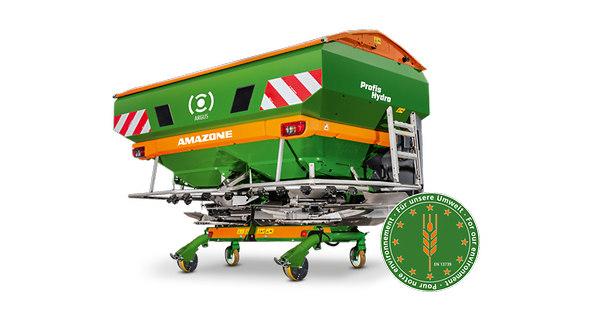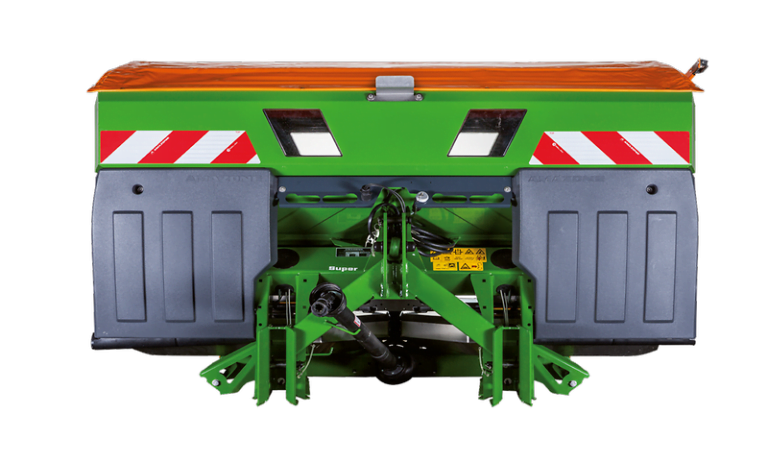
The ZA-TS mounted spreader is available with a tank capacity ranging from 1,400 l to 4,200 l and is equipped with the new TS spreader unit. The TS spreader unit provides working widths of up to 54 m together with excellent border spread patterns. The ISOBUS spreader ZA-TS is one of the best high output spreaders.
The reliable weighing technology, the AutoTS and ClickTS precise border spreading systems as well as the innovative ArgusTwin and WindControl technology and a large number of other options put the fertiliser spreader in a class of its own.


| Frames and hoppers – Robustness is the key | 3200-4500kg payload Lightweight frame design with excellent rigidity Optimised centre of gravity and yet plenty of space for hitching up |
| The deep-drawn hopper | The base hopper has a volume of 700 l. This provides a continual and even distribution of the fertiliser. Also the cleaning of the spreader is made easy thanks to this design. |
| The extensions: In two widths and many sizes | For a subsequent increase in hopper capacity for the ZA-TS, AMAZONE offers for both the S and L base machines a suitable bolt-on extension. The volume of these bolt-on extensions is 600 l for the S hopper width and 800 l for the L hopper width. |
| SafetySet – integrated as standard | The SafetySet, which is fitted as standard equipment ensures improved safety. The surrounding guard tube fulfils the accident prevention regulations. Large-dimensioned marker boards to the rear and the road lighting kit ensure better visibility in road traffic. |
| Profis weighing technology – Who weighs wins! | No calibration. Just enter the spread rate and drive off! There is nothing simpler. The weighing system offers controlled comfort as well as peace of mind. It works on-line to determine the different characteristics of the material to be spread via two 200 Hz weigh cells with the highest degree of measuring accuracy. It automatically compares the actual applied rate with the pre-determined rate. Deviations in flow behaviour, such as, for example with blended mineral fertilisers, are detected and the spreader automatically re-adjusts via the electric metering slides. The quantity applied is also precisely documented for the purpose of site-specific nutritional application. The application rate can be changed at the touch of a button via the ISOBUS terminal to provide a balanced nutrient supply. |
| Tilt sensor for steeper sloping terrain | Any possible influences due to a change in the centre of gravity are taken into account on the Profis by the on-the-move signal from the tilt sensor. The two-dimensional tilt sensor, which detects angles to the front and back or side to side, corrects any errors in the measuring procedure which might occur when driving up and down hills or when driving across a slope. |
| Low level sensors | When spreading on slopes or when border spreading it can happen that one hopper tip is emptied quicker than the other. In order to check each outlet apertures individually, AMAZONE therefore additionally offers low level hopper sensors. With a premature emptying of one side, the relevant hopper tip is indicated in red in the operator terminal so that the driver is warned in good time. |
| The spreading disc drive – Mechanical or hydraulic, choose for yourself! | Tronic – mechanical spreading disc drive The spreader unit is driven via the PTO shaft in the Tronic version. Here the spreader is, as standard, protected from overload via a friction clutch on the PTO shaft. The input speed from the tractor PTO is transmitted via the central gearbox resulting in an increased spreading disc speed. This allows fertilisation at low engine revs across the maximum working width. With the mechanically driven spreaders, either 8 or 16 part-width sections are switchable, depending on the operator terminal. Hydro – hydraulic spreading disc drive he Hydro version makes operation possible irrespective of the tractor’s engine revs and with different spreading disc speeds. In this way, fuel is saved and a particularly comfortable and precise spreading is ensured. The spreader also operates at different spreading disc speeds in border spreading, meaning that the best possible lateral distribution can be achieved in the overlap areas as well as at the field boundary. Depending on the operator terminal, the hydrolic operated spreader can be swtitched from 8 to a max. 128 part-width sections. |
| Border spreading systems | Side spreading (yield oriented setting), Boundary spreading (environmentally oriented setting), Water course spreading (environmentally oriented setting), Side spreading – first tramline at the field edge |
| EasyCheck – Precise spreading made easy! | Digital, mobile test kit for the simple optimisation of lateral distribution Instead of the test trays found in the normal mobile test kit, the EasyCheck System consists of only 16 lightweight rubber collecting mats and the EasyCheck App for smartphones. The collecting mats are positioned at specific distances away from the tramline. The corresponding tramlines are then spread and the mats with the collected fertiliser granules are photographed via a smartphone. The App now automatically compares how much fertiliser has been collected on the individual test mats and puts the results of the individual rows into an average. If the spreading result is not ideal, the App proposes an appropriate correction for the adjustment of the respective fertiliser spreader. |
| HeadlandControl – Optimum lateral distribution on the headland | When HeadlandControl is activated, the throwing width and spread rate are increased on the inner field side, so that the switch-off point is moved towards the inside of the field. Furthermore, the new part-width section control, which is now adapted to the shape of the spread fan, causes the part-width sections to be switched off from the outside to the inside when entering the headland. Over- and under-fertilised zones on the headland are subsequently avoided. |
| Do | |
| NOT DELETE | |
| THIS TABLE | |
| IT CREATES CSS THAT IS USED | |
| in the ACF Repeater | |
| JET Engine fields | |
| for the engine specs - Ken | |
| DEF (AdBlue) Capacity |